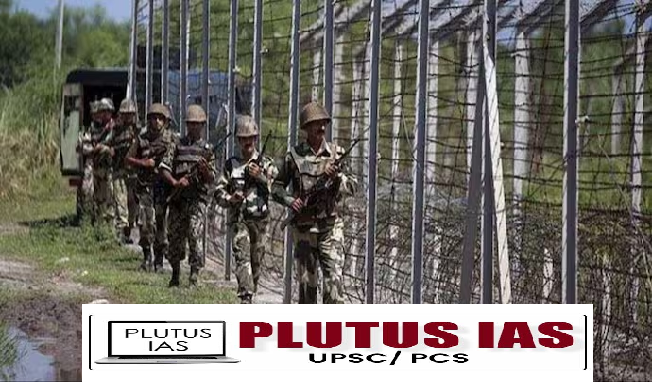27 Sep Internal Security Challenges In Border Areas
Posted at 27 Sep 2024
in
Current Affairs
by Ritik singh
SYLLABUS MAPPING:
GS-3- Internal Security–Internal Security Challenges In Border Areas
FOR PRELIMS:
Examine the internal security challenges prevalent along the Indo-Myanmar border, considering factors such as insurgency, smuggling, community relations, and geopolitical dynamics.
FOR MAINS:
Analyze the internal security challenges along the Indo-Myanmar border, focusing on the impact of ethnic insurgencies, cross-border smuggling, and the role of local communities. Discuss the implications for national security and potential strategies for effective border management and regional cooperation.
RECENT CONTEXT:
The Indo-Myanmar border, stretching approximately 1,643 kilometers, has become a focal point for India’s security and diplomatic efforts, particularly in light of recent developments in regional security dynamics, ethnic insurgencies, and cross-border activities. The government has initiated several programs aimed at enhancing security, fostering development, and building better relationships with local communities.
BORDER DATA:
The Indo-Myanmar border extends approximately 1,643 kilometers, connecting the Indian states of Arunachal Pradesh, Nagaland, Manipur, and Mizoram with Myanmar. This border region is characterized by diverse ethnic communities and complex socio-political dynamics. Key statistics related to the border include:
Length: 1,643 km
States Involved: Arunachal Pradesh, Nagaland, Manipur, Mizoram
Border Districts: Several districts along the border are significantly affected by cross-border issues, including insurgency and smuggling.
Cross-Border Population: The border is home to numerous ethnic groups, which often have familial ties across the border, complicating security dynamics.

KEY GOVERNMENT INITIATIVES:
1.Border Area Development Programme (BADP):
To promote socio-economic development in border areas through infrastructure improvement, education, and healthcare facilities.
2.Integrated Border Management System (IBMS):
To utilize advanced technology for enhanced surveillance and management of borders, thereby improving response capabilities to security threats.
3.Border Village Programme:
To uplift the living standards of residents in border villages through targeted development projects, including roads, electricity, and sanitation.
4.Strengthening Border Infrastructure:
To upgrade and construct roads, communication networks, and border outposts, which will facilitate better movement of security forces and enhance surveillance capabilities.
5.Joint Task Force Initiatives:
To enhance collaboration between Indian security forces and their Myanmar counterparts for coordinated efforts against cross-border crime and insurgency.
6.Skill Development and Livelihood Programs:
To empower local communities through skill training and entrepreneurship support, reducing economic dependency on illegal activities. By providing sustainable livelihoods, the government aims to mitigate factors that contribute to unrest.
7.Promotion of Cross-Border Trade:
To facilitate legitimate trade between India and Myanmar, encouraging economic interdependence while discouraging illegal smuggling.
CHALLENGES IN BORDER AREAS:
1.Insurgency and Ethnic Tensions:
The Indo-Myanmar border is home to various ethnic armed groups that often engage in violent conflicts. This insurgency complicates law enforcement and fosters an environment of instability.
2.Cross-Border Smuggling:
The porous nature of the border facilitates the smuggling of drugs, weapons, and goods. This illegal trade not only undermines security but also contributes to organized crime and local violence.
3.Illegal Immigration:
Unregulated immigration from Myanmar can strain local resources, leading to demographic shifts and increased competition for jobs and services, which may escalate tensions between communities.
4.Corruption:
Corruption within law enforcement agencies can hinder effective policing, allowing illegal activities to proliferate and eroding public trust in authorities.
5.Limited Infrastructure:
Many border areas suffer from inadequate infrastructure, such as poor roads and insufficient communication systems. This hampers effective governance and the ability of security forces to respond swiftly to threats.
6.Community Distrust:
Mistrust between local populations and security forces can complicate cooperation and intelligence-gathering efforts, making it harder to address security challenges effectively.
7.Environmental and Geographic Barriers:
The rugged terrain and dense forests present operational challenges for surveillance and law enforcement, limiting the reach of security forces.
WAY FORWARD:
1.Strengthening Community Engagement:
Building trust with local communities is essential. Initiatives should focus on regular dialogue, involving residents in security planning and development projects to foster cooperation.
2.Investment in Infrastructure:
Upgrading roads, communication networks, and public services in border areas can enhance governance and improve the quality of life, addressing the socio-economic root causes of unrest.
3.Enhanced Training for Law Enforcement:
Capacity-building programs focused on community policing, counter-insurgency, and intelligence gathering can empower local security forces to better handle challenges.
4.Bilateral Cooperation with Myanmar:
Strengthening diplomatic ties and operational cooperation with Myanmar can improve regional security. Joint training exercises and intelligence sharing can enhance operational effectiveness against cross-border issues.
5.Economic Development Initiatives:
Promoting skill development and entrepreneurship can create sustainable livelihoods, reducing dependency on illegal activities. Economic empowerment is key to mitigating unrest.
6.Utilization of Technology:
Investing in advanced surveillance technologies can enhance border management. Tools like drones and integrated monitoring systems can improve situational awareness and response capabilities.
7.Regular Monitoring and Evaluation:
Establishing mechanisms for ongoing assessment of security initiatives and development programs will ensure adaptability to changing circumstances and challenges.
CONCLUSION:
The challenges along the Indo-Myanmar border are multifaceted, encompassing issues like insurgency, smuggling, and community distrust. Addressing these challenges requires a comprehensive and integrated approach that combines security measures with socio-economic development. By fostering community engagement, improving infrastructure, and enhancing bilateral cooperation with Myanmar, India can create a more secure and stable border environment. A proactive strategy that addresses both security and developmental concerns will ultimately contribute to lasting peace and prosperity in this strategically important region.

PRELIMS QUESTION:
Q.Which of the following are significant internal security challenges faced along the Indo-Myanmar border?
A. Insurgency and Ethnic Conflicts
B. Cross-Border Smuggling
C. Inadequate Infrastructure
D. Community Trust and Relations
Select the correct options:
a) 1, 2, 3, 4
b) 2, 3, 5
c) 1, 2, 4
Answer Key:A
MAINS QUESTION:
Q.Critically analyze the internal security challenges faced along the Indo-Myanmar border, focusing on issues such as insurgency, cross-border smuggling, and community relations. Discuss the implications of these challenges for national security and propose effective strategies for addressing them?





No Comments